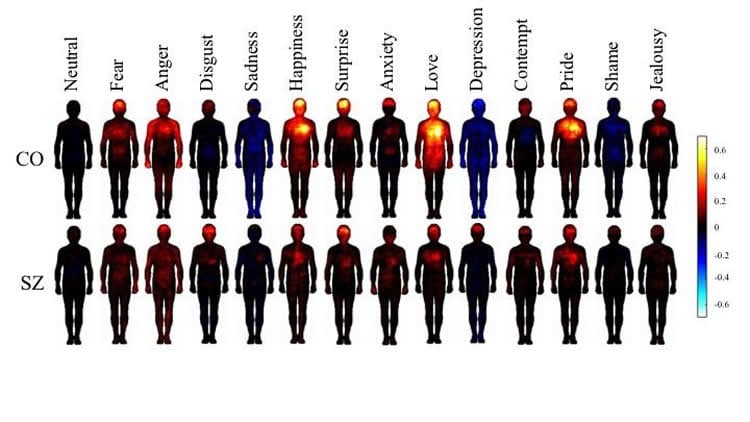Summary: Study reveals those with schizophrenia have an overall reduction of bodily sensations across all emotions, where as those without the disorder show specific patterns of increase arousal and decreased energy across the body for each emotion.
Source: Vanderbilt University.
Colorful figures of the human body are helping Vanderbilt University researchers understand how people experience emotion through their bodies and how this process is radically altered in people with schizophrenia.
Sohee Park, Gertrude Conaway Vanderbilt Professor of Psychology, and Ph.D. student Lénie J. Torregrossa compared individuals with schizophrenia with matched control participants, asking each to fill in a “body map” in a way that correlates to the way they physically experience emotion. They used a computerized coloring task to locate where participants feel sensations when they experience, for example, anger or depression.
The outcomes differed radically between groups, with the control group showing distinct maps of sensations for 13 different emotions, indicating specific patterns of increased arousal and decreased energy across the body for each emotion. However, in individuals with schizophrenia, there was an overall reduction of bodily sensation across all emotions.
The study also found that individuals with schizophrenia don’t differentiate on their body maps for varying emotions. That may pose a problem for them in identifying, recognizing and verbalizing their emotions or trying to understand the emotions of others.

Torregrossa said the research will allow the team to move forward in developing ways to help people with schizophrenia process emotions, which, in turn, could improve interpersonal relationships.
“The main outcome of this research is that we have a better understanding of why people with schizophrenia might have trouble interacting with others,” she said. “What we can do now is help them learn to attend to physiological sensations arising from their bodies and use them to process emotions.”
Source: Heidi Hall – Vanderbilt University
Publisher: Organized by NeuroscienceNews.com.
Image Source: NeuroscienceNews.com image is credited to Sohee Park.
Original Research: Abstract for “Anomalous Bodily Maps of Emotions in Schizophrenia” by Lénie J Torregrossa, Matthew A Snodgress, Seok Jin Hong, Heathman S Nichols, Enrico Glerean, Lauri Nummenmaa, and Sohee Park in Schizophrenia Bulletin. Published December 14 2018.
doi:10.1093/schbul/sby179
[cbtabs][cbtab title=”MLA”]Vanderbilt University”People with Schizophrenia Experience Emotions Differently From Others, Body Map Shows.” NeuroscienceNews. NeuroscienceNews, 21 December 2018.
<https://neurosciencenews.com/body-map-schizophrenia-emotion-10388/>.[/cbtab][cbtab title=”APA”]Vanderbilt University(2018, December 21). People with Schizophrenia Experience Emotions Differently From Others, Body Map Shows. NeuroscienceNews. Retrieved December 21, 2018 from https://neurosciencenews.com/body-map-schizophrenia-emotion-10388/[/cbtab][cbtab title=”Chicago”]Vanderbilt University”People with Schizophrenia Experience Emotions Differently From Others, Body Map Shows.” https://neurosciencenews.com/body-map-schizophrenia-emotion-10388/ (accessed December 21, 2018).[/cbtab][/cbtabs]
Abstract
Anomalous Bodily Maps of Emotions in Schizophrenia
Objective
Embodied emotions arise from interoceptive and somatosensory processes, and are essential to the development of a stable sense of self. Emotional embodiment is therefore inherently interwoven with our sense of bodily self-awareness, and allows us to navigate complex social situations. Given that the core feature of schizophrenia (SZ) is characterized by the presence of bodily self-disturbances and social-emotional deficits, we hypothesized that embodiment of emotion would be disrupted in SZ.
Method
Twenty-six medicated individuals with SZ and 26 demographically matched controls used a computerized topographical mapping tool (“EmBODY”) to indicate on a body outline where they felt bodily sensations while experiencing an emotion. There were 13 different emotions plus a neutral state. The resulting bodily maps of emotions were quantitatively compared between groups using linear discriminant analysis and similarity scores.
Results
Bodily maps of emotions were anomalous in SZ as indicated by indistinguishable maps across different emotions. Relative to the control group, patients reported less discrete and less clear bodily sensations across emotions. In particular, bodily maps for low-arousal emotions were atypical in comparison with healthy controls.
Conclusions
Anomalous and undifferentiated mapping of embodied emotions in SZ could lead to deficits in linking bodily sensations to conceptual categories of emotions. Disrupted emotional embodiment could also contribute to poor social functioning. Abnormal bodily sensations of emotions might therefore be a promising target for future psychosocial interventions.






